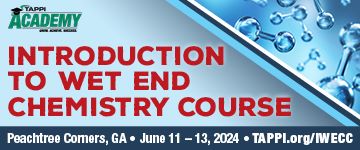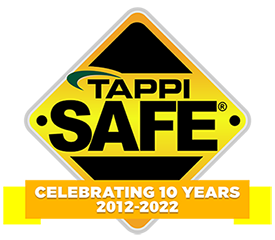 Search
Search
Use the search bar or filters below to find any TAPPI product or publication.
Filters
Content Type
Publications
Level of Knowledge
Committees
Collections
Magazine articles

The application of continuous improvement principles and methods to safety, TAPPI JOURNAL, November 1997, Vol. 80(11)
The application of continuous improvement principles and methods to safety, TAPPI JOURNAL, November 1997, Vol. 80(11)
Magazine articles

Technology spotlight: the paper machine of tomorrow - maintenance and engineering, TAPPI JOURNAL, September 1998, Vol. 81(9)
Technology spotlight: the paper machine of tomorrow - maintenance and engineering, TAPPI JOURNAL, September 1998, Vol. 81(9)
Magazine articles

On-line corrosion monitoring in kraft white liquor clarifiers, TAPPI JOURNAL, June 1996, Vol. 79(6)
On-line corrosion monitoring in kraft white liquor clarifiers, TAPPI JOURNAL, June 1996, Vol. 79(6)
Magazine articles

Comprehensive safety training programs, TAPPI JOURNAL, July 1996, Vol. 79(7)
Comprehensive safety training programs, TAPPI JOURNAL, July 1996, Vol. 79(7)
Magazine articles

Capital cost analysis looks at recent and future trends, TAPPI JOURNAL, November 1992, Vol. 75(11)
Capital cost analysis looks at recent and future trends, TAPPI JOURNAL, November 1992, Vol. 75(11)
Magazine articles

China: now and in the future, TAPPI JOURNAL, May 1996, Vol. 79(5)
China: now and in the future, TAPPI JOURNAL, May 1996, Vol. 79(5)
Magazine articles

1994 polymers, laminations and coatings conference highlights technology basics, TAPPI JOURNAL, December 1994, Vol. 77(12)
1994 polymers, laminations and coatings conference highlights technology basics, TAPPI JOURNAL, December 1994, Vol. 77(12)
Magazine articles

More than 420 attend polymers, laminations and coatings division annual conference, TAPPI JOURNAL, January 1993, Vol. 76(1)
More than 420 attend polymers, laminations and coatings division annual conference, TAPPI JOURNAL, January 1993, Vol. 76(1)
Magazine articles

Fifth international printing and graphic arts conference: a joint success, TAPPI JOURNAL, June 1991, Vol. 74(6)
Fifth international printing and graphic arts conference: a joint success, TAPPI JOURNAL, June 1991, Vol. 74(6)
Magazine articles

Controlling anaerobic bacteria to improve product quality and mill safety, TAPPI JOURNAL, February 1991, Vol. 74(2)
Controlling anaerobic bacteria to improve product quality and mill safety, TAPPI JOURNAL, February 1991, Vol. 74(2)






